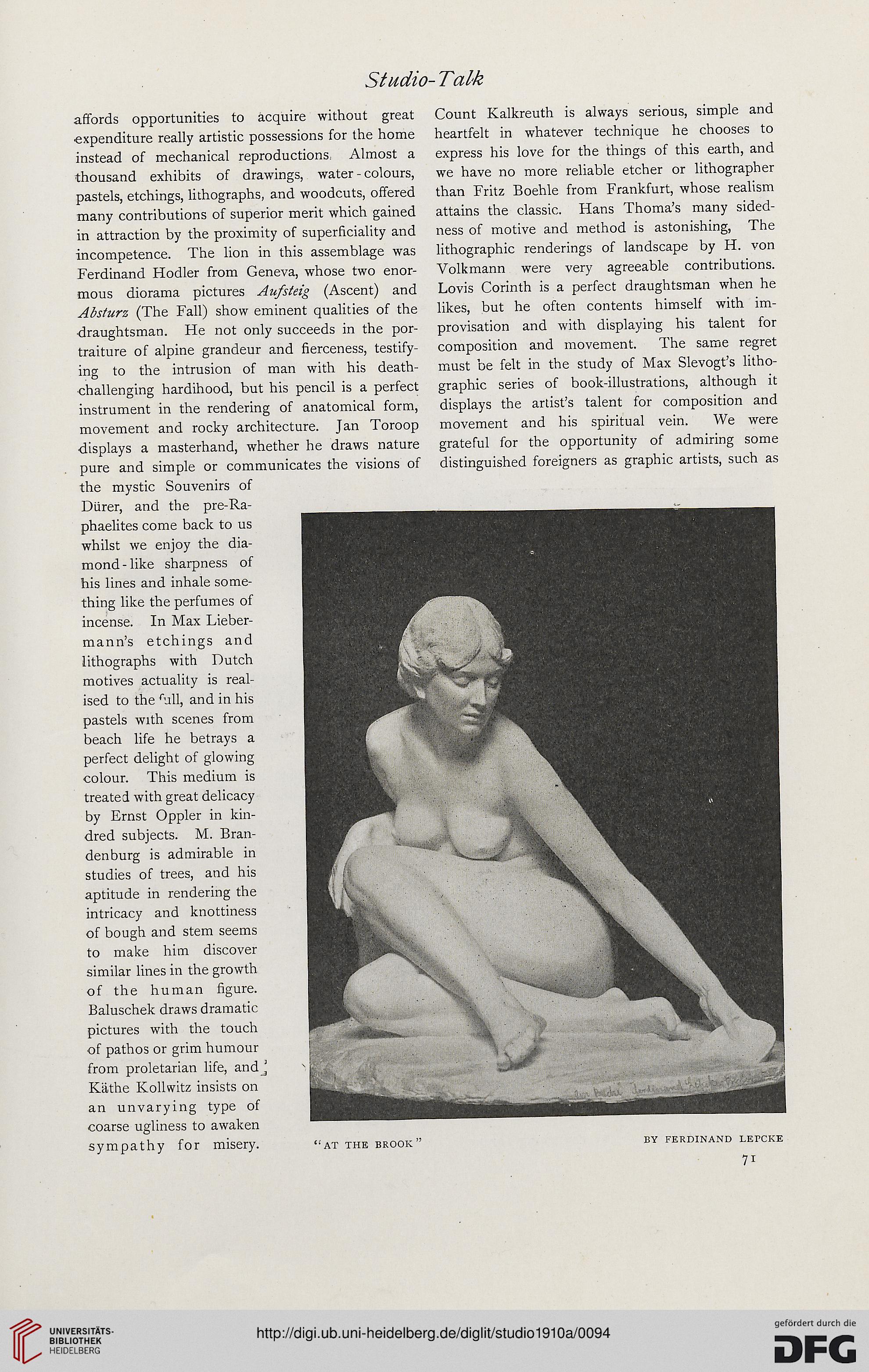Studio-Talk
affords opportunities to acquire without great
expenditure really artistic possessions for the home
instead of mechanical reproductions, Almost a
thousand exhibits of drawings, water - colours,
pastels, etchings, lithographs, and woodcuts, offered
many contributions of superior merit which gained
in attraction by the proximity of superficiality and
incompetence. The lion in this assemblage was
Ferdinand Hodler from Geneva, whose two enor-
mous diorama pictures Aufsteig (Ascent) and
Absturz (The Fall) show eminent qualities of the
■draughtsman. He not only succeeds in the por-
traiture of alpine grandeur and fierceness, testify-
ing to the intrusion of man with his death-
challenging hardihood, but his pencil is a perfect
instrument in the rendering of anatomical form,
movement and rocky architecture. Jan Toroop
displays a masterhand, whether he draws nature
pure and simple or communicates the visions of
the mystic Souvenirs of
Diirer, and the pre-Ra-
phaelites come back to us
whilst we enjoy the dia-
mond - like sharpness of
his lines and inhale some-
thing like the perfumes of
incense. In Max Lieber-
mann’s etchings and
lithographs with Dutch
motives actuality is real-
ised to the hill, and in his
pastels with scenes from
beach life he betrays a
perfect delight of glowing
colour. This medium is
treated with great delicacy
by Ernst Oppler in kin-
dred subjects. M. Bran-
denburg is admirable in
studies of trees, and his
aptitude in rendering the
intricacy and knottiness
of bough and stem seems
to make him discover
similar lines in the growth
of the human figure.
Baluschek draws dramatic
pictures with the touch
of pathos or grim humour
from proletarian life, andj
Kiithe Kollwitz insists on
an unvarying type of
coarse ugliness to awaken
sympathy for misery. “at the brook” by Ferdinand letcke
7i
Count Kalkreuth is always serious, simple and
heartfelt in whatever technique he chooses to
express his love for the things of this earth, and
we have no more reliable etcher or lithographer
than Fritz Boehle from Frankfurt, whose realism
attains the classic. Hans Thoma’s many sided-
ness of motive and method is astonishing, The
lithographic renderings of landscape by H. von
Volkmann were very agreeable contributions.
Lovis Corinth is a perfect draughtsman when he
likes, but he often contents himself with im-
provisation and with displaying his talent for
composition and movement. The same regret
must be felt in the study of Max Slevogt’s litho-
graphic series of book-illustrations, although it
displays the artist’s talent for composition and
movement and his spiritual vein. We were
grateful for the opportunity of admiring some
distinguished foreigners as graphic artists, such as
affords opportunities to acquire without great
expenditure really artistic possessions for the home
instead of mechanical reproductions, Almost a
thousand exhibits of drawings, water - colours,
pastels, etchings, lithographs, and woodcuts, offered
many contributions of superior merit which gained
in attraction by the proximity of superficiality and
incompetence. The lion in this assemblage was
Ferdinand Hodler from Geneva, whose two enor-
mous diorama pictures Aufsteig (Ascent) and
Absturz (The Fall) show eminent qualities of the
■draughtsman. He not only succeeds in the por-
traiture of alpine grandeur and fierceness, testify-
ing to the intrusion of man with his death-
challenging hardihood, but his pencil is a perfect
instrument in the rendering of anatomical form,
movement and rocky architecture. Jan Toroop
displays a masterhand, whether he draws nature
pure and simple or communicates the visions of
the mystic Souvenirs of
Diirer, and the pre-Ra-
phaelites come back to us
whilst we enjoy the dia-
mond - like sharpness of
his lines and inhale some-
thing like the perfumes of
incense. In Max Lieber-
mann’s etchings and
lithographs with Dutch
motives actuality is real-
ised to the hill, and in his
pastels with scenes from
beach life he betrays a
perfect delight of glowing
colour. This medium is
treated with great delicacy
by Ernst Oppler in kin-
dred subjects. M. Bran-
denburg is admirable in
studies of trees, and his
aptitude in rendering the
intricacy and knottiness
of bough and stem seems
to make him discover
similar lines in the growth
of the human figure.
Baluschek draws dramatic
pictures with the touch
of pathos or grim humour
from proletarian life, andj
Kiithe Kollwitz insists on
an unvarying type of
coarse ugliness to awaken
sympathy for misery. “at the brook” by Ferdinand letcke
7i
Count Kalkreuth is always serious, simple and
heartfelt in whatever technique he chooses to
express his love for the things of this earth, and
we have no more reliable etcher or lithographer
than Fritz Boehle from Frankfurt, whose realism
attains the classic. Hans Thoma’s many sided-
ness of motive and method is astonishing, The
lithographic renderings of landscape by H. von
Volkmann were very agreeable contributions.
Lovis Corinth is a perfect draughtsman when he
likes, but he often contents himself with im-
provisation and with displaying his talent for
composition and movement. The same regret
must be felt in the study of Max Slevogt’s litho-
graphic series of book-illustrations, although it
displays the artist’s talent for composition and
movement and his spiritual vein. We were
grateful for the opportunity of admiring some
distinguished foreigners as graphic artists, such as




